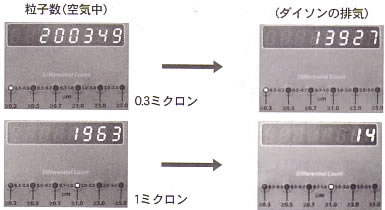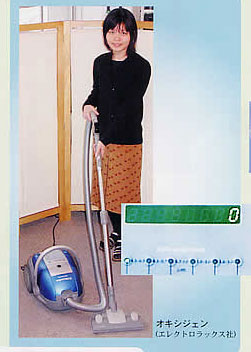| |
|
Independent Test By Consumer Organization Reveals Problems Japan Offspring Fund tested Dyson, a much advertised vacuum cleaner of the cyclone type. It is designed to be air-tight so there is not supposed to be any place where exhaust leaks and comes out. Because exhaust comes out of just the air exit, we measured the dust particles there, and got the following results:
Because the particle counter detected few particles at 1 micron emitted from the Dyson, we assume that there were no particles that were the size 2 micron or larger. It must be noted that dust and mold particles as well as pollen are pulverized in vacuum cleaners. Thus, they are released into the air from the air exit. Comparing Dyson and Electrolux Oxygen When Japan Offspring Fund tested the Electrolux Oxygen, all the particle counts were 0 (zero). In other words, no particles of any size are emitted from this vacuum cleaner. That is a very good result. Electrolux Oxygen is a vacuum cleaner we can recommend.
(Picture:) The meter shows the exhaust emitted from Electrolux Oxygen contains zero dust In reality, this result is enormously difficult for us to understand. Of course, if you are a person who protects a manufacturer of other models of vacuum cleaners, you can argue a lot about the different size of dust particles. Yes, your model may suck up the dust at 100 microns, the pollen at 10 microns, even most of the particles at 5 microns. Will you argue that this or that result is sufficient? From our point of view, avoiding the risk of an allergic reaction of a child is the starting-point. Or how about elderly, or people with weak immune systems? It is especially disturbing to hear the arguments from salesmen who promote Japanese domestic vacuum cleaners, using a lot of questionable tactics, when their products are clearly inferior. "Rather Dangerous" Dyson has advertised its model as a type which an English allergy association has recommended. Because the Dyson vacuum cleaner cannot completely remove fragments of allergens that are 1 micron or less in size, we showed the results to Dr. Terasawa. He expressed the following opinion: "It is rather dangerous to use a vacuum cleaner that emits a lot of particles that are 0.3 microns in size. The prevention of allergy, hay fever, and asthma cannot be achieved with that kind of low exhaust efficiency."
|
|||||||||||||||||||||||||||||||||||||||||||||||||||||||||
|
Copyright(C) 2004 Japan Offspring Fund, All Rights Reserved. Tel:048-851-1212 Fax:048-851-1214 Mail: Please give me the subject name in Japanese. |


